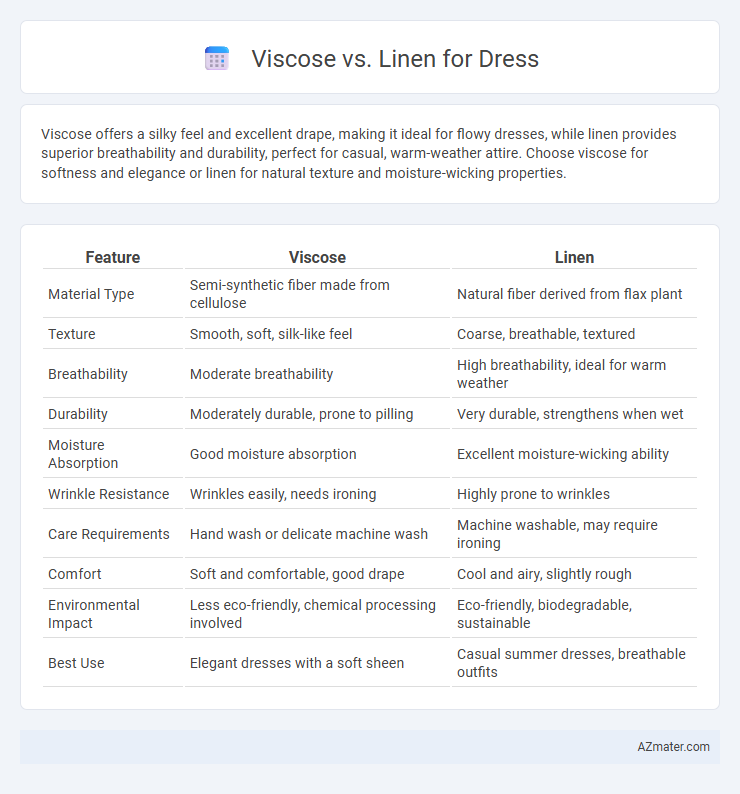Viscose offers a silky feel and excellent drape, making it ideal for flowy dresses, while linen provides superior breathability and durability, perfect for casual, warm-weather attire. Choose viscose for softness and elegance or linen for natural texture and moisture-wicking properties.
Table of Comparison
| Feature | Viscose | Linen |
|---|---|---|
| Material Type | Semi-synthetic fiber made from cellulose | Natural fiber derived from flax plant |
| Texture | Smooth, soft, silk-like feel | Coarse, breathable, textured |
| Breathability | Moderate breathability | High breathability, ideal for warm weather |
| Durability | Moderately durable, prone to pilling | Very durable, strengthens when wet |
| Moisture Absorption | Good moisture absorption | Excellent moisture-wicking ability |
| Wrinkle Resistance | Wrinkles easily, needs ironing | Highly prone to wrinkles |
| Care Requirements | Hand wash or delicate machine wash | Machine washable, may require ironing |
| Comfort | Soft and comfortable, good drape | Cool and airy, slightly rough |
| Environmental Impact | Less eco-friendly, chemical processing involved | Eco-friendly, biodegradable, sustainable |
| Best Use | Elegant dresses with a soft sheen | Casual summer dresses, breathable outfits |
Understanding Viscose and Linen Fabrics
Viscose is a semi-synthetic fiber made from regenerated cellulose, offering a soft, breathable, and lightweight fabric ideal for flowy, comfortable dresses. Linen, derived from flax fibers, provides excellent durability, moisture-wicking properties, and a natural texture that enhances breathability and cooling effects in warm weather. Understanding these fabric compositions helps in selecting dresses suitable for comfort, maintenance, and seasonal wear.
Key Differences Between Viscose and Linen
Viscose and linen differ significantly in fiber origin and texture, with viscose being a semi-synthetic fiber derived from wood pulp and linen made from natural flax fibers. Viscose offers a smooth, silky feel and excellent drape, making it ideal for flowy dresses, while linen is known for its crisp texture, breathability, and natural moisture-wicking properties, perfect for structured summer garments. Linen tends to be more durable and environmentally friendly but wrinkles easily, whereas viscose requires careful washing to maintain softness and shape.
Comfort and Breathability Comparison
Viscose offers a soft, smooth texture with good moisture absorption, making it comfortable for warm weather but less breathable than linen. Linen provides superior breathability and moisture-wicking properties due to its natural fiber structure, ensuring better airflow and a cooler feel during hot climates. For dresses prioritizing comfort in high temperatures, linen typically outperforms viscose in maintaining dryness and preventing overheating.
Durability and Longevity: Viscose vs Linen
Linen offers superior durability and longevity compared to viscose due to its natural fiber strength and resistance to wear over time. Viscose, while soft and breathable, tends to weaken with repeated washing and prolonged exposure to moisture, reducing its lifespan. Choosing linen for dresses ensures a sturdier fabric that maintains its structure and appearance through frequent use and laundering.
Care and Maintenance Requirements
Viscose dresses require gentle washing in cold water and should be air-dried flat to prevent shrinking and fabric damage, while avoiding direct sunlight to maintain color vibrancy. Linen dresses are more durable, tolerating machine washes on a gentle cycle with mild detergent and benefit from ironing while damp to reduce wrinkles. Both fabrics demand careful handling to preserve texture and appearance, but linen offers easier maintenance with increased resistance to wear over time.
Eco-Friendliness and Sustainability
Viscose and linen differ significantly in eco-friendliness and sustainability, with linen being a more environmentally responsible choice due to its natural fibers sourced from flax plants requiring minimal water and pesticides. Viscose production involves chemically intensive processes and often utilizes wood pulp from unsustainable logging, raising concerns about deforestation and chemical waste. Choosing linen dresses supports sustainable agriculture and biodegradability, whereas viscose dresses typically carry a larger ecological footprint.
Cost Factors: Which Fabric is More Affordable?
Viscose dresses are generally more affordable due to lower production costs and the use of wood pulp as a raw material, making them a budget-friendly option. Linen, derived from flax fibers, involves a more labor-intensive manufacturing process and higher-quality sourcing, resulting in increased price points. Consumers often find viscose appealing for cost-effective fashion, while linen's durability and natural texture justify its premium cost.
Best Uses for Viscose Dresses
Viscose dresses are ideal for casual and evening wear due to their soft texture, breathability, and excellent drape, which enhances silhouette flattering. Unlike linen, viscose resists wrinkling, making it perfect for long-lasting comfort and a polished look throughout the day. The fabric's moisture-wicking properties and lightweight feel ensure comfort in warm weather, positioning viscose as a top choice for stylish, breathable dresses.
Best Uses for Linen Dresses
Linen dresses excel in hot and humid climates due to their natural breathability and moisture-wicking properties, making them ideal for summer wear and beach outings. The fabric's durability and lightweight texture provide a comfortable fit for casual day events and garden parties. Linen's ability to age beautifully with soft wrinkles enhances its appeal for relaxed yet stylish dresses suitable for everyday wear.
Choosing the Right Fabric for Your Next Dress
Viscose offers a soft, lightweight texture with excellent drape, making it ideal for flowy, comfortable dresses, while linen provides breathability, durability, and a natural, textured look perfect for warm weather and casual styles. When choosing the right fabric for your next dress, consider the climate, desired comfort level, and the dress's style--viscose excels in softness and fluidity, whereas linen stands out for its cooling properties and organic feel. Both fabrics require proper care to maintain their appearance, with viscose needing gentle washing and linen benefiting from natural fiber preservation techniques.

Infographic: Viscose vs Linen for Dress
 azmater.com
azmater.com